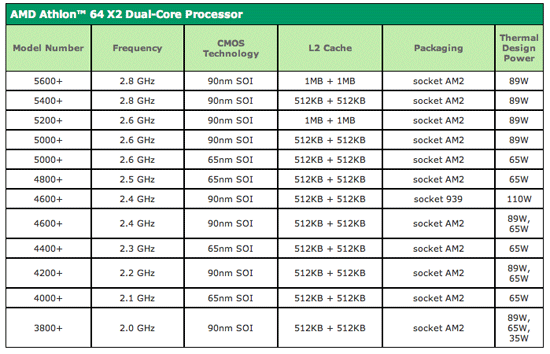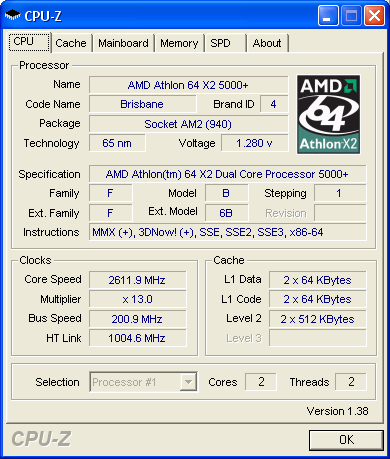AMD's 65nm Brisbane Core Previewed: The most energy efficient AMD CPU to date
by Anand Lal Shimpi on December 14, 2006 6:08 PM EST- Posted in
- CPUs
When Intel launched its Core 2 line of processors we saw AMD's performance and power advantages vanish into thin air but the comparison, at least on the power side, wasn't totally fair. Intel had been shipping desktop processors on its 65nm process for months prior to the launch of Core 2, while AMD's Athlon 64 X2s were still built on a 90nm process. We had no way of telling how much of Intel's power advantage was due to a more efficient architecture or simply smaller, cooler running transistors. Up to now, AMD has been penalized twice in all Core 2 vs. Athlon 64 X2 comparisons; AMD's new micro-architecture won't debut until next year and neither will 65nm in any great quantities.
Technically in-line with roadmaps, AMD just introduced and announced shipment of its first 65nm cores: codenamed Brisbane. Availability is another story entirely, as it's looking like we won't see any real quantities of these things until Q1 2007. Right now AMD's Brisbane chips are strictly OEM only and AMD wasn't able to give us an indication of when to expect retail/channel availability. Of course we wouldn't be talking about this today if we didn't have a chip, which we do, but for all intents and purposes you can consider this a preview of what to expect in the new year from AMD's first 65nm chips.
AMD announced its Brisbane lineup earlier this month, the chips and basic specs are listed below:

As you can expect, AMD is pricing the 65nm chips in line with its 90nm offerings to encourage the transition. Die size and TDP have both gone down to 126 mm^2 and 65W across the line. As AMD improves its 65nm SOI process you can expect to see even lower wattage parts, but for now all of the 65nm chips are rated at 65W TDP.
Transistor count remains unchanged at 154M as there is no new functionality or cache introduced with the move to 65nm. Once again, we will have to wait until around the middle of 2007 before we'll see any major changes to AMD's architecture.

The chip we received was AMD's 65nm Athlon 64 X2 5000+ and from the outside, it looks just like a normal X2. The only way to tell that this is a 65nm chip is by looking at the OPN.

Armed with the chip and its $301 price point we set out to compare its performance, power consumption and power efficiency to AMD's other 90nm CPUs and the closest price competitor from Intel: the Core 2 Duo E6600 priced at $316.










63 Comments
View All Comments
Anand Lal Shimpi - Friday, December 15, 2006 - link
Part 2 is coming Monday with Brisbane 4800+ results :)Take care,
Anand
Anand Lal Shimpi - Monday, December 18, 2006 - link
Just an update guys - Part 2 is ready to go, just waiting for a few clarifications from AMD on performance, memory dividers and die size of Brisbane.Take care,
Anand
OcHungry - Friday, December 15, 2006 - link
Mr. Anand, is it possible that you use Asus's Crosshair motherboard if attempting for the max overclocking of these 65nm's? It's only fair when you use top Intel board but leave out top AM2 board. I have an understanding that Asus's Crosshair board is ~ 15%-17% better performer than other boards. Also I've heard that the DFI board is a great Overclocker and you have used it on the s939 reviews. I would appreciate it if you use either board, but preferably the Asus Crosshair.Thanks.clairvoyant129 - Sunday, December 17, 2006 - link
A different motherboard won't save this sorry ass piece of junk.Anand Lal Shimpi - Friday, December 15, 2006 - link
Unfortunately I don't have either of those boards here for testing, but I'm sure I can persuade either Gary or Wes to do a follow-up with a more serious look at 65nm overclocking once I'm done with the power analysis on these chips. :)Take care,
Anand
xenon74 - Friday, December 15, 2006 - link
Jarred, why is then HT Link @ 1125Mhz on Anand's "unfortunate" OC attempt?ADDAvenger - Friday, December 15, 2006 - link
Anyone else wondering what this means for the new generation of Turion X2s?I know Santa Rosa is coming out either Q1 or Q2 this year; it's supposed to support an 800 or 400mhz FSB, depending on system load, which should drop power consumption a bit. But, as I understand it, the real battery suckers are CPU, display, and HDD. (Yeah throw in GPU too if you have discrete graphics.) But where does that leave the chipset, will Santa Rosa really do much for battery life?
If not, AMD could make serious inroads into the laptop segment. 65W is hot for a laptop, but if they can drop their desktop TDPs by about a 1/3 or 1/4, why can't they do the same for their laptop chips?
mino - Friday, December 15, 2006 - link
They can. And they will...FYI even 90nm Turions consume LESS power than Merom. (Merom is more power hungry than Yonah).
Also RS690M is about to rule the integrated market (along with RS700M for C2D). In other word AMD is gonna rule the chipset market for both platforms while beeing pretty competitive in CPU's, especially for bussiness use.
(for bussiness the features and battery life is what counts, not the absolute performance)
Johnmcl7 - Friday, December 15, 2006 - link
Not according to Anandtech:http://www.anandtech.com/cpuchipsets/showdoc.aspx?...">http://www.anandtech.com/cpuchipsets/showdoc.aspx?...
Shows power consumption to be as near as identical between the two processors.
Not sure if you are comparing Turion or Turion X2 to Merome but aside from mismatched comparisons (such as comparing the power consumption of a Turion system with onboard graphics and Merom with dedicated graphics) I've not seen like for like tests showing Turions to be more power efficient:
"Does that make the Core 2 Duo worse at power saving than Turion X2? Without equivalent setups (i.e. both using IGP or both using discrete GPUs), we can't say for certain. We can say that an ASUS W5F with a T2300 chip (1.67GHz 2MB cache) that we had at one point bottomed out at 19W in idle mode, so Core Duo and Turion X2 appear close in low power states, with Turion X2 perhaps holding a slight 1-2W advantage. Our testing of Core Duo vs. Core 2 Duo showed the CPUs to be nearly equal in power draw, so it appears AMD is equal or slightly better than Intel at minimum power draw. At maximum power draw by the CPU, Turion X2 is definitely using more power than Core 2 Duo, as even with higher performance/power components the ASUS A8JS still uses less power than the MSI TL-60 at 100% CPU load."
http://www.anandtech.com/showdoc.aspx?i=2856&p...">http://www.anandtech.com/showdoc.aspx?i=2856&p...
John
rqle - Friday, December 15, 2006 - link
Darn, was so hoping AMD 65nm would give an easy 3.3ghz+ like the intel chips =(. This chip may not reflect overall OC, but it damn hovering around my AMD range of 2.6-2.8 again. A 2.66-2.7 OC intel is > then 2.9ghz AMD. Ill just waited again.